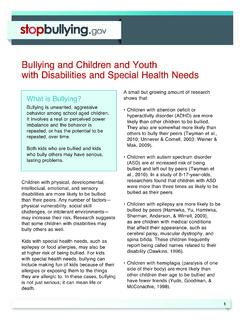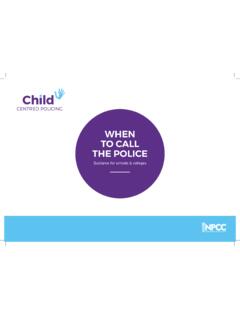Transcription of 10 Common Myths of Child Abuse - National Children’s ...
1 10 common myths about Child Abuse Child Abuse only happens in some parts of of PHYSICAL Abuse AND NEGLECT are a ected by socioeconomic status. It is Child SEXUAL Abuse perpetration/victimization that occurs in all parts of society. children are victimized by creepy psychopathic 2015, percent of victims (all types) were maltreated by one or both parents. Other perpetrators known to victims included foster parents, other relatives, neighbors, and daycare providers. For Child SEXUAL Abuse , about 90% of victims know their abuser. children usually tell someone they are being children lie about being has found that most Child victims delay or never disclose Child SEXUAL Abuse to friends, family or the authorities 4,5,6 False allegations of SEXUAL Abuse by children and adolescents are statistically uncommon, occurring at the rate of 2 to 10 percent of all cases.
2 <10%12345If a Child has been sexually abused, there will be medical evidence is found is less than 5% of substantiated Child SEXUAL Abuse , 10 The most Common type of Abuse children experience at home is sexual Abuse . Child NEGLECT is the most Common type of Abuse experienced in the who are sexually abused as boys all grow up to sexually Abuse sexual Abuse victims rarely go on to become perpetrators of sexual , 137 Continued on reverse side 2018 National children s Advocacy Center. All rights reserved. men sexually Abuse are less traumatized as victims of sexual Abuse than with disabilities are less likely to become victims of Abuse than children without least 20% of substantiated Child sexual Abuse cases are perpetrated by females. 14, 15, 16 The severity of traumatization among male victims of sexual Abuse is equal to that of female victims.
3 17, 18, 19, 20 children with disabilities are two to three times more likely than children without disabilities to experience Abuse . 21, 22, 23, 241. Department of Health & Human Services, Administration for children and Families, Administration on children , Youth and Families, children s Bureau. (2017). Child Maltreatment 2015. Washington DC: Centers for Disease Control and Prevention (2016). Child Abuse and Neglect: Risk and Protective Factors. Atlanta, GA: Author. Finkelhor, D. (2012). Characteristics of crimes against juveniles. Durham, NH: Crimes against children Research Bottoms, B., Rudnick, A., & Epstein, A. (2007). A retrospective study of factors a ecting the disclosure of childhood sexual and physical Abuse . In Pipe, M. E., Lamb, Y., Orbach, Cederborg, C. (Eds.), Child sexual Abuse : Disclosure, delay, and denial (pp.)
4 175-194). Mahwah, NJ: Lawrence Erlbaum London, K., Bruck, M., Ceci, S. J., & Shuman, D. W. (2005). Disclosure of Child sexual Abuse : What does the research tell us about the ways that children tell? Psychology, Public Policy, and Law, 11(1), 194 London, K., Bruck, M., Wright, D. B., & Ceci, S. J. (2008). Review of the contemporary literature on how children report sexual Abuse to others: Findings, methodological issues, and implications for forensic interviewers. Memory, 16(1), Mikkelsen, E. J., Gutheil, T. G., & Emens, M. (1992). False sexual- Abuse allegations by children and adolescents: Contextual factors and clinical subtypes. American Journal of Psychotherapy, 46(4), Hansen, D. J., & Wilson, K. R. (2007). Child sexual Abuse . In B. L. Cutler (Ed.), Encyclopedia of Psychology and Law (pp.
5 1-5). Newbury Park, CA: SAGE Heger, A., Ticson, L., Velasquez, O., & Bernier, R. (2002). children referred for possible sexual Abuse : Medical ndings in 2384 children . Child Abuse & Neglect, 26(6), Adams, J. A., Harper, K., Knudson, S., & Revilla, J. (1994). Examination ndings in legally con rmed Child sexual Abuse : It's normal to be normal. Pediatrics, 94(3), Department of Health & Human Services, Administration for children and Families, Administration on children , Youth and Families, children s Bureau. (2017). Child Maltreatment 2015. Washington, DC: Leach, C., Stewart, A., & Smallbone, S. (2016). Testing the sexually abused-sexual abuser hypothesis: A prospective longitudinal birth cohort study. Child Abuse & Neglect, 51, Widom, C. S., & Massey, C. (2015). A prospective examination of whether childhood sexual Abuse predicts subsequent sexual o ending.
6 JAMA Pediatrics, 169(1), e143357- McLeod, D. A. (2015). Female o enders in Child sexual Abuse cases: A National picture. Journal of Child Sexual Abuse , 24(1), Green, A. H. (1999). Female sex o enders. In J. A. Shaw (Ed.), Sexual aggression (pp. 195-210). Washington, DC: American Psychiatric Association Finkelhor, D., Williams, L. M., Burns, N., & Kalinowski, M. (1988). Nursery crimes: Sexual Abuse in day care. Sage Publications, Dube, S. R., Anda, R. F., Whit eld, C. L., Brown, D. W., Felitti, V. J., Dong, M., & Giles, W. H. (2005). Long-term consequences of childhood sexual Abuse by gender of victim. American Journal of Preventive Medicine, 28(5), Sigmon, S. T., Greene, M. P., Rohan, K. J., & Nichols, J. E. (1997). Coping and adjustment in male and female survivors of childhood sexual Abuse .
7 Journal of Child Sexual Abuse , 5(3), Spataro, J., Mullen, P. E., Burgess, P. M., Wells, D. L., & Moss, S. A. (2004). Impact of Child sexual Abuse on mental health. British Journal of Psychiatry, 184, 416 Heath, V., Bean, R., & Feinauer, L. (1996). Severity of childhood sexual Abuse : Symptom di erences between men and women. American Journal of Family Therapy, 24, 305 Rand, M. L., & Harrell, E. (2007). Crime Against People with disabilities , 2007. Washington, DC: Bureau of Justice Bryen, D. N. (2002). End the Silence. Issues in Special Education & Rehabilitation, 17(2), 7 Marini, Z., Fairbairn, L., & Zuber, R. (2001). Peer harassment in individuals with developmental disabilities : Towards the development of multi-dimensional bullying identi cation model. Developmental disabilities Bulletin, 29(2), 170 Sobsey, D.
8 , & Mansell, S. (1994). Sexual Abuse patterns of children with disabilities . The International Journal of children s Rights, 2.







